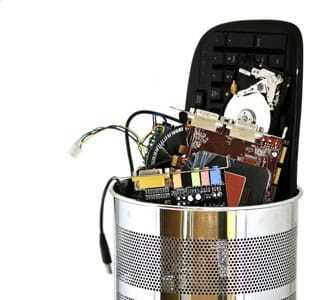 Just about every household in Australia has at least one, if not two computers. And just about every family in Australia has at least one mobile phone. We purchase the latest technological updates with abandon and enthusiasm, and while these new toys are fun, fast and fabulous, do we often stop to think about our cast-offs and our discarded electronic equipment? We might pass them on to our children or relatives, but eventually they will find their way to the local garbage or landfill site.
Just about every household in Australia has at least one, if not two computers. And just about every family in Australia has at least one mobile phone. We purchase the latest technological updates with abandon and enthusiasm, and while these new toys are fun, fast and fabulous, do we often stop to think about our cast-offs and our discarded electronic equipment? We might pass them on to our children or relatives, but eventually they will find their way to the local garbage or landfill site.
Electronic waste – or e-waste – as it is more commonly referred to these days, comprises the surplus and the broken or discarded electrical devices we know longer use or need. In both developed and undeveloped countries this form of waste pollution is of major concern mainly because this specific form of waste contains a series of hazardous substances that can be extremely toxic to humans, the groundwater table, landfill sites and the environment in general.
The range of toxic substances in e-waste includes:
- Americium (a known carcinogen)
- Mercury (in flat screen monitors)
- Cadmium (in rechargeable batteries)
- Lead
- Beryllium oxide
- Polyvinyl chloride[1]
According to a United Nations report titled “Recycling- from E-waste to resources, “the world is heading for a potentially devastating deluge of electronic waste as many nations struggle to keep the sheer volumes they are facing under control.”[2] Huge mounds of hazardous waste from electronic products are growing fast, particularly in many developing regions with rates of growth as high as 500%.
What is most concerning is that much of the hazardous waste is handled carelessly and often, as is the case in China, “incinerated by backyard recyclers who recover valuable metals and in the process release plumes of far-reaching toxic pollution into the atmosphere.”[3]
The Executive Director of the United Nations Environment Programme (UNEP) Achim Steiner added that “China is not alone in facing a serious problem. India, Brazil, Mexico and others may also face rising environmental damage and health problems if e-waste recycling is left to the vagaries of the informal sector.”[4]
Solutions
UNEP’s view is solutions to the problem of backyard burning of the e-waste to obtain the metals are possible with government and business help.
It noted that a pilot programme in Bangalore in southern India reveals ‘state of the art recycling plants, building on existing organisations working in the areas of recycling and waste management” are the way for the future. The implication for other countries such as Brazil, Colombia, Mexico, and Africa and China, as well as other under-developed countries where the practice is widespread, is huge.
It remains clear that the challenge of dealing with e-waste represents an extremely important and significant step in the transition to a green economy. All nations need to take heed, given the increasingly significant role electronics and new technologies play in our lives. These devices are here to stay. Large scale and responsibly controlled and overseen modes of recycling of these technologies will help to minimise the toxic release of their substances into the earth’s atmosphere.
Join the green revolution. Support green industry. Phone Envirosafe Solutions on 1300 889070.
[1] http://en.wikipedia.org/wiki/Electronic_waste
[2] http://www.un.org/apps/news/story.asp?NewsID=33845&Cr=waste&Cr1
[3] http://www.un.org.au/apps/news/story.asp?News=33845&Cr=waste&Cr1
[4] ibid



















